POWDER ANALYSIS
Powder characterization testing refers to a set of analytical techniques used to measure and describe powders' physical and chemical properties. These tests can help to determine essential powder properties such as flowability, compressibility, particle size, particle shape, density, and flow measurement, among others. As a result, the tests are essential for understanding the behavior of powders in various industrial processes, including manufacturing, processing, handling, and storage stages of production. This ensures uniformity between batches, as well as predictable manufacturing outcomes.
Powder characterization is used in various industries, and the results of these tests can help manufacturers optimize their processes, improve product quality and consistency, and reduce waste and costs.
Powder Characterization Analysis Tests
—In a Carney flow test, a known powder mass is placed into a cylinder with a specific diameter and height. The cylinder is raised and tilted, and the powder flows out of the cylinder and into a funnel. The amount of time it takes—In a Hall flow test, a known mass of powder is placed into a funnel with a specific diameter and height, the funnel is raised, and the time it takes is measured.
Flow Tests - Hall flow testing and Carney flow testing measure the flow properties of the powder, which is important for determining how a powder behaves during handling, transportation, and processing. Powder characterization testing can involve various methods, either separately or in combination, including:
Material Verification—ICP and ICP-MS Analysis determine the elemental composition of a sample material using a spectrometer, which analyzes vaporized and ionized particles (ICP) or detects ions based on their mass-to-charge ratio (ICP-MS).
Microtrac Laser Diffraction is a non-destructive test method that analyzes diffracted light passing through a sample. This test provides fast and accurate particle size information with minimal sample preparation required. It is highly accurate and precise, making it a valuable tool for ensuring the consistency of product quality.
Sieve Analysis – A non-destructive testing technique that involves the separation of particles of different sizes using a series of sieves with progressively smaller mesh sizes. Once all of the material is passed through the sieves, the amount of material remaining on each sieve is weighed, a calculation of the percentage of material in each size fraction is done, and the data is plotted on a particle size distribution curve, which shows the percentage of particles in each size range.
Flow Tests—Hall flow testing and Carney flow testing measure the powder's flow properties, which are important for determining how a powder behaves during handling, transportation, and processing.
- Hall Flow Test—In a Hall flow test, a known mass of powder is placed into a funnel with a specific diameter and height, the funnel is raised, and the time it takes for the powder to flow through is measured and used to calculate the Hall flow rate.
- Carney Flow Test—In a Carney flow test, a known mass of powder is placed into a cylinder with a specific diameter and height. The cylinder is raised and tilted, and the powder flows out of the cylinder and into a funnel. The amount of time it takes for the powder to flow through is measured and used to calculate the Carney flow rate.
Apparent Density – Apparent density is a measure of the density of a powder, including any voids or spaces between the particles. It is typically determined by measuring the mass of a known powder volume. Apparent density is an important parameter in powder handling and processing, as it can affect the flow properties of the powder. Powders with a higher apparent density tend to have a slower Hall flow rate, indicating lower flowability. Apparent density is determined as the mass of the powder per unit of volume (g/cm3).
Tap Density (Packed Density)—A tap density test measures the density of a powder under controlled conditions of tapping or vibration. It is determined by measuring the mass of a powder sample after it has been subjected to a specific number of taps or vibrations. The powder's tap density is influenced by particle size, shape, surface area, and interparticle forces. Tap density is determined as the powder mass per volume unit (g/cm3).
Helium Pycnometry – Helium pyncometry is a highly accurate and precise test that determines the density of materials by measuring the volume of helium gas displaced by a solid sample, which is measured and calculated using the known volume of helium and the mass of the sample. It is particularly effective for materials with high porosity or surface roughness. This method is commonly used in the field of material sciences to determine the density of solid materials, particularly those with small particle sizes or complex shapes. The information this test generates is important for applications where the density of materials affects their performance, such as in the development of lightweight materials for aerospace or automotive applications.
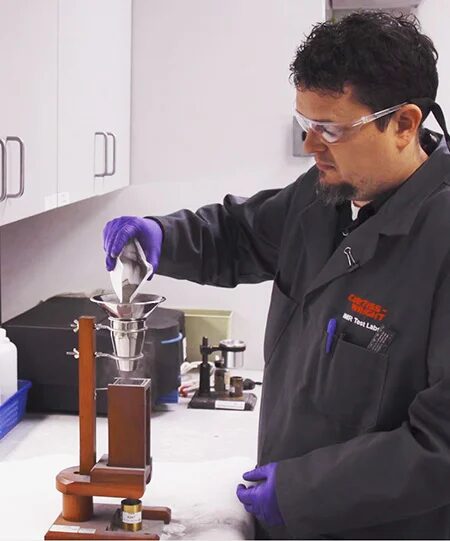
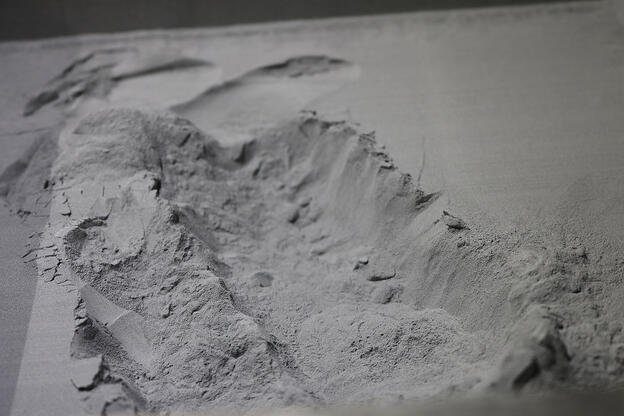
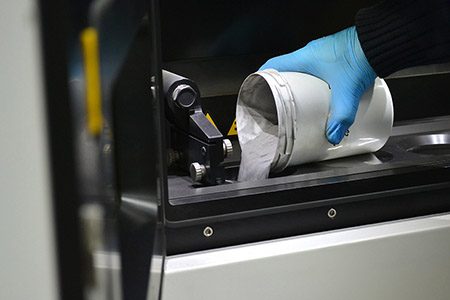
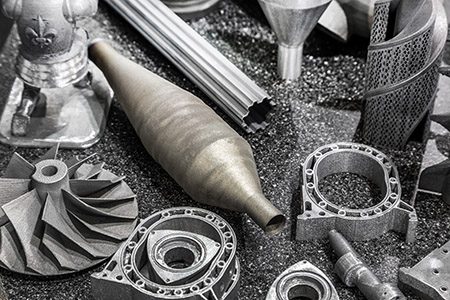
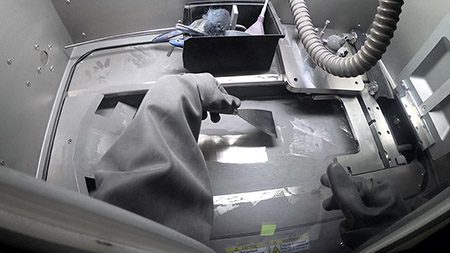
Industry Applications for Powder Characterization
Aerospace
Powder characterization is an important tool in the aerospace industry for optimizing the properties and performance of advanced materials used in various aerospace applications. The information obtained from powder characterization testing can be used to optimize the manufacturing process and predict the behavior of powders during processing and service.
Additive Manufacturing
Powder characterization plays a critical role in the additive manufacturing industry, also known as 3D printing, which is a rapidly growing field that enables the creation of complex parts with high precision and resolution. Powder characterization is used to optimize the properties of the powders used in additive manufacturing processes, which can significantly affect the quality and performance of the final product.
Automotive/Transportation
Powder characterization is an important tool in the automotive industry for optimizing the properties and performance of various automotive components that rely on powdered materials. The information obtained from powder characterization testing can be used to optimize the manufacturing process and predict the behavior of powders during processing and service, resulting in high-quality and reliable automotive components.
Chemical
Powder characterization is an essential tool in the chemical industry for optimizing the properties and performance of various chemical products that rely on powdered materials. The information obtained from powder characterization testing can be used to optimize the manufacturing process and predict the behavior of powders during processing and service, resulting in high-quality and reliable chemical products. Chemical products may include catalysts, pigments, polymers, pharmaceuticals, cosmetics, and food additives.
Alloy Chemistry
Antimony Analysis (ICP)
Ash Content
Cadmium Analysis (ICP)
Carbon, Sulfur, Hydrogen, Oxygen & Nitrogen
Chemical Resistance
Cleanliness Testing
Coating Weights
Coefficient of Thermal Expansion
Conductivity (ASTM D1125)
Contaminant/ Corrodent Analysis
Degree of Crystallinity
Degree of Cure
Density of Powdered Metals
Dynamic Mechanical Analysis (DMA)
Filler/Additive Analysis
FTIR
Halogen Analysis (IC)
Heavy Metals Analysis
Hex Chrome (UV-VIS)
ICP-AES Analysis
ICP-MS Analysis
Impurities Analysis
Ion Chromatography
Material Certification
Melt Flow Rate & Viscosity
Melting Point & Glass Transition
Metal Purity
OES Analysis
On-site PMI
PMI Testing (Positive Material ID)
Particle Size Analysis
Percent Crystallinity
pH
Phase Identification
Polymer Testing
Powder Diffraction
Powdered Metal Analysis
Precious Metal Assay
Quantitative Analysis
Resistivity (ASTM D1125)
SEM-EDS
Semi-Quantitative Analysis
Sieve Analysis
Tap Density
Trace Element Analysis
Unknown Alloy Identification
Unknown Material Identification
XRD Analysis
XRF Analysis
MATERIALS TESTED WITH POWDER CHARACTERIZATION METHODS
Metals
- Aluminum
- Titanium
- Nickel
- Cobalt
- Copper
- Iron Alloys
Ceramics
Minerals
Polymers
POWDER CHARACTERIZATION FAQ
Powder characterization refers to the measurement and analysis of various physical properties of powdered materials, including particle size, shape, distribution, surface area, and density.
Powder characterization is important because it provides valuable information about the physical properties of powdered materials, which can be used to optimize their performance and behavior during processing and service.
Some common techniques used in powder characterization include microtec laser diffraction, material verification, sieve analysis, Hall flow rate, Carney flow rate, tap density, apparent density, and helium pyncometry.
Powder characterization can help with quality control by providing detailed information about the physical properties of powdered materials, which can be used to identify potential quality issues and ensure that the materials meet the desired specifications.
RELEVANT ACCREDITATIONS
Click here for a complete list of accreditations and certifications for all IMR Test Labs locations.


